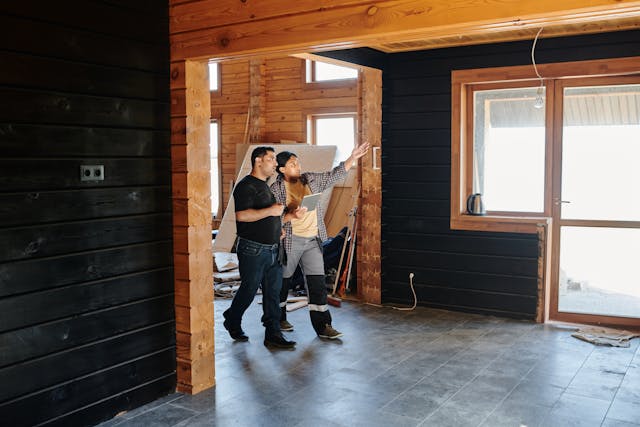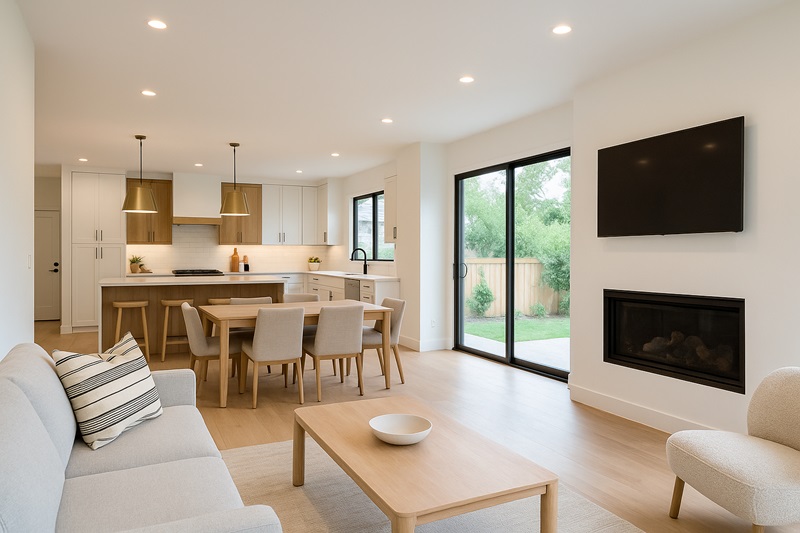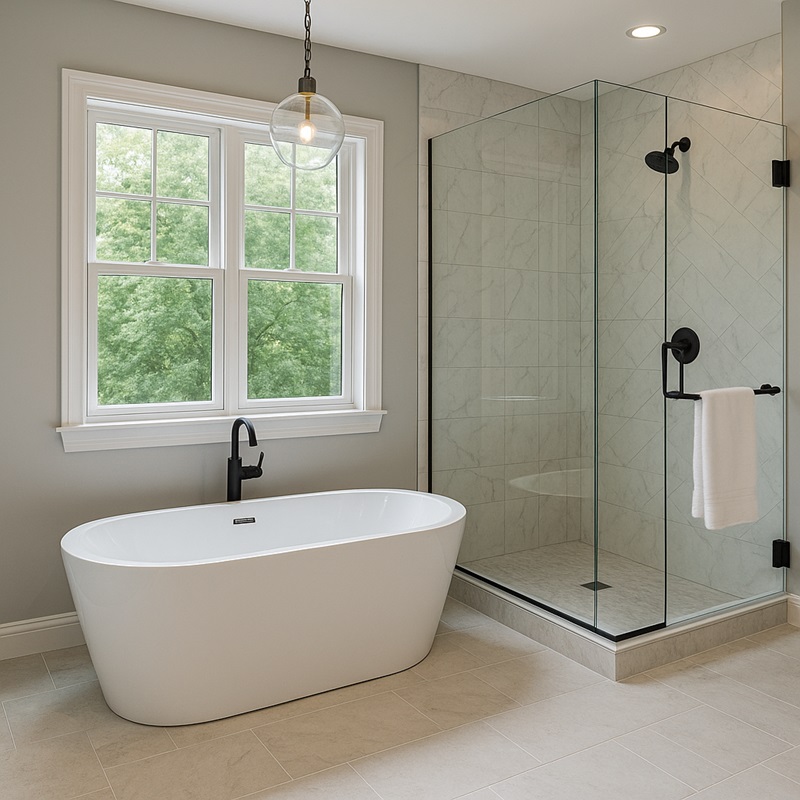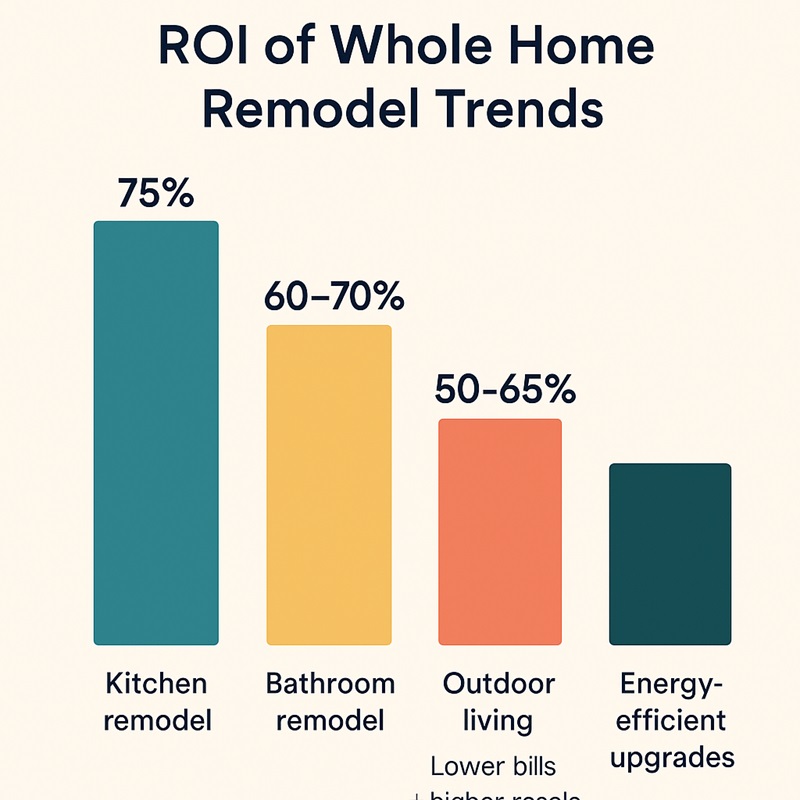A whole home remodel is more than a project — it’s a complete change to how you live. In the USA, many homeowners remodel not only for comfort but also to raise property value. From energy-saving upgrades to stylish kitchens, the right choices can make daily life easier and help your home sell for more.
This guide looks at the newest whole home remodel trends in the USA. These designs add lasting value, improve function, and make homes more sustainable and appealing to buyers.
Why Whole Home Remodel Trends Matter for Homeowners
Remodeling is one of the biggest investments you can make. Following trends is not just about style — it’s about meeting buyer needs and creating long-term use.
- Resale value: Many remodel features raise home prices and market appeal.
- Lifestyle fit: Open layouts and smart upgrades make living easier.
- Sustainability: Energy-efficient updates save money and reduce harm to the planet.
In today’s market, the right remodel choices let you enjoy your home now and increase your return later.
Whole Home Remodel Costs in the USA
Average cost range: According to HomeAdvisor, a whole home remodel in the USA typically costs $100,000 to $300,000+, depending on home size, location, and materials.
Breakdown of expenses:
- Kitchens: $25,000–$75,000+
- Bathrooms: $10,000–$40,000
- Living areas & bedrooms: $20,000–$50,000
- Structural changes (walls, roofing, foundations): $30,000–$100,000+
Regional variations: Remodeling a home in California or New York can cost 20–40% more than in the Midwest or South due to labor and material costs.
Hidden costs: Permits, inspections, and temporary housing add extra expenses homeowners often overlook.
How Long Does It Take?
Average duration: A complete remodel often takes 4–8 months, though larger homes or projects requiring structural changes can extend past a year.
Phases of a remodel:
- Planning & design: 1–3 months
- Permits & approvals: 1–2 months
- Demolition & construction: 3–6 months
- Final finishes & inspections: 1–2 months
Delays to expect: Supply chain issues, labor shortages, or weather can add weeks.
Tip for homeowners: Build in at least 10–15% buffer time beyond the estimated timeline to stay realistic.
Top Whole Home Remodel Trends in the USA
Open Concept and Flexible Floor Plans
Open floor plans remain one of the most popular updates in American homes. Families want spaces that feel connected, with kitchens opening to living and dining areas.
- Walls are replaced with islands, beams, or dividers.
- Flexible layouts let rooms switch between dining, work, or entertainment.
- Value impact: Buyers love the open feel because it makes homes look bigger and more welcoming.
Pro tip: If a full open layout isn’t possible, use wider doorways, half-walls, or sliding partitions.
Sustainable and Eco-Friendly Designs
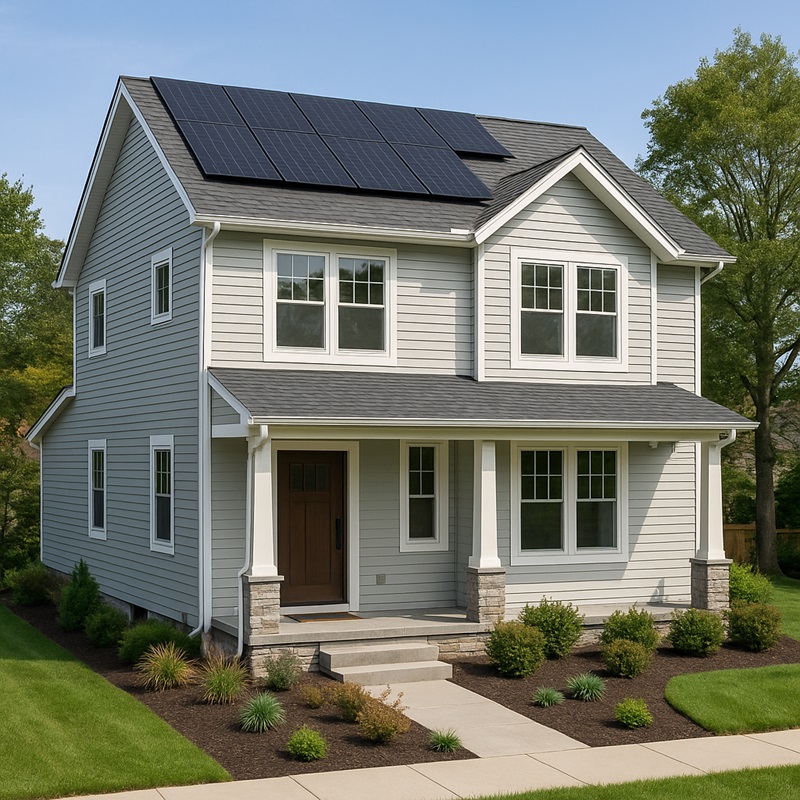
Sustainability has gone mainstream. Homeowners want remodels that save energy and protect the planet.
- Energy upgrades: Low-E windows, insulated siding, and efficient HVAC systems.
- Eco-materials: Bamboo floors, recycled glass counters, reclaimed wood.
- Green energy: Solar panels, EV charging stations, and smart thermostats.
Why it matters: Eco-friendly upgrades save money over time and appeal to buyers willing to pay more for efficiency.
Smart Home Technology Integration
Technology is now part of modern remodels. Homeowners expect smart features built in.
- Smart lighting and dimmers for mood and savings.
- Security systems with cameras and sensors.
- Voice-activated devices for appliances and climate control.
- Energy monitors that track usage in real time.
Adding tech during a remodel is easier than later and makes homes “future-ready” for resale.
Luxury Kitchens with Practical Upgrades
Kitchens are still the heart of the home — and the top remodel project in the USA. Modern upgrades mix style with function.
- Quartz countertops that are durable and low-maintenance.
- Large islands for cooking, eating, and gathering.
- Walk-in pantries with custom storage.
- Energy-efficient appliances with sleek finishes.
Value impact: Kitchen remodels give some of the best returns on investment.
Spa-Like Bathrooms
Bathrooms are no longer just for function — they’re becoming spaces for relaxation.
- Freestanding tubs and curbless showers.
- Heated floors and towel racks.
- Smart mirrors with anti-fog settings.
- Water-saving fixtures that cut bills but keep comfort.
These upgrades create daily luxury and attract buyers who see bathrooms as a key decision point.
Outdoor Living Spaces and Indoor-Outdoor Flow
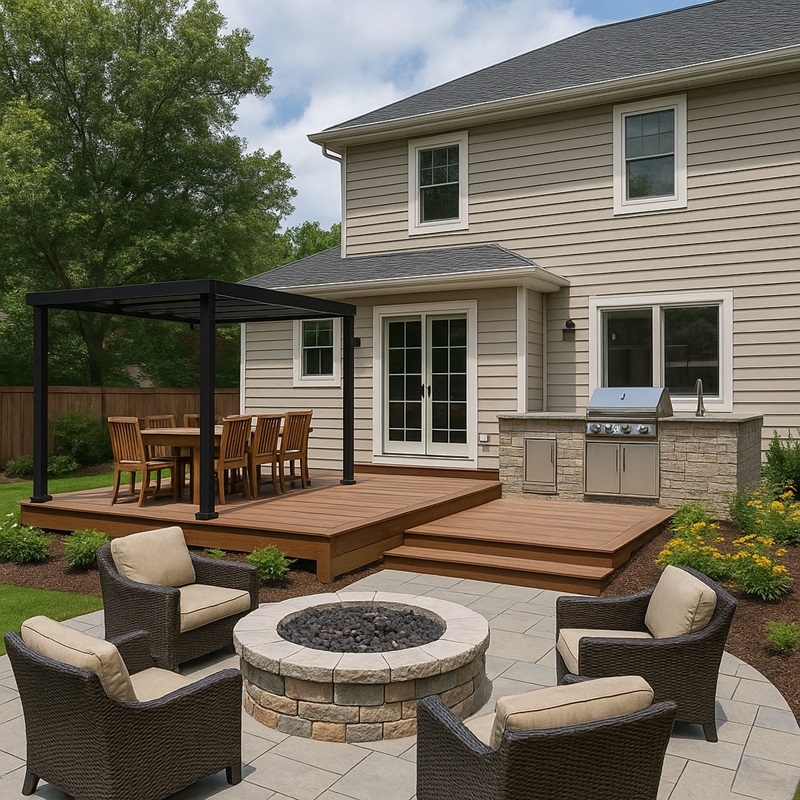
The demand for outdoor living grew during the pandemic and continues today.
- Sliding glass walls and French doors that connect inside and outside.
- Outdoor kitchens with grills, sinks, and storage.
- Covered patios, decks, and fire pits for year-round use.
- Landscaping with native plants that need less water and care.
Why it matters: Adding outdoor space is like adding square footage — but often at a lower cost.
Home Offices and Remote Work Spaces
Remote work has permanently reshaped housing needs. Whole home remodels increasingly include dedicated office spaces.
- Built-in desks and shelving maximize small areas.
- Soundproofing helps professionals focus.
- Flexible layouts allow rooms to shift between work and guest space.
Even a modest home office can be a major selling point in today’s housing market.
Regional Whole Home Remodel Trends in the USA
West Coast
- Strong demand for eco-friendly remodels: solar panels, sustainable materials, minimalist modern design.
- Indoor-outdoor living is a must.
East Coast
- Blending historic character with modern amenities.
- Smart storage solutions for smaller urban homes.
Midwest
- Focus on durable finishes for family-friendly living.
- Open layouts that connect kitchens and living rooms.
South
- Outdoor kitchens and screened porches are popular.
- Energy efficiency upgrades to combat hot, humid climates.
Where to Start With a Whole Home Remodel
Step 1: Define your goals — Decide whether your remodel is for lifestyle improvement, resale value, or both.
Step 2: Set a budget range — Use national cost averages as a guide, but adjust for your region and priorities.
Step 3: Prioritize projects — Kitchens, bathrooms, and energy-efficient upgrades often deliver the most value.
Step 4: Hire professionals early — Involve contractors, architects, and designers at the start to avoid costly changes mid-project.
Step 5: Plan financing — Explore home equity loans, cash-out refinancing, or renovation loans.
How These Trends Add Long-Term Value
Not every remodel gives the same return. Here are the projects that add the most value:
Kitchen Remodel: Up to 75% ROI
The kitchen is the top selling point in U.S. homes. A midrange remodel can bring back up to 75% of costs. Luxury kitchens may return a bit less, but they still attract buyers. Features like quartz counters, stainless steel appliances, and open layouts make a big difference. Updated kitchens also help homes sell faster compared to outdated ones.
Bathroom Remodel: 60–70% ROI
Bathrooms also add strong value. A modest remodel can return 60–70% of costs. Premium upgrades, such as walk-in showers, soaking tubs, and double vanities, may give lower ROI but raise buyer interest. Adding water- and energy-saving fixtures makes bathrooms even more appealing, especially for eco-conscious buyers.
Energy-Efficient Upgrades: Lower Bills + Higher Value
Upgrades like efficient windows, HVAC systems, insulation, and appliances cut bills and add resale value. The U.S. Department of Energy says energy-smart homes can lower utility costs by 25–30% each year. These upgrades appeal most to millennial and Gen Z buyers who value sustainability. In many states, tax credits and rebates make the ROI even better.
Outdoor Living Spaces: 50–65% ROI
Outdoor spaces have become more popular since 2020. Adding a patio, deck, or outdoor kitchen can return 50–65% of costs, depending on the design. These areas also make a home feel larger by extending usable space. Homes with outdoor living often sell faster, especially in warmer climates where people can use them year-round.
Remodel or Buy New?
Many homeowners ask if it’s better to remodel or buy a new home. The answer depends on budget, lifestyle, and the housing market.
Key points to consider:
- Costs: Remodeling often runs between $100K and $300K or more. Buying new comes with higher upfront costs, closing fees, and moving expenses.
- Location: If you love your neighborhood, remodeling lets you stay while upgrading your home.
- Customization: Remodels give you control over design. New builds may limit choices based on the developer.
- Timeline: Buying new can be faster than an 8–12 month remodel. But housing shortages may slow the search.
- Value: A remodel can boost resale value. Buying new often means paying more for a move-in-ready home.
Verdict: If your home has a solid structure and you value your location, remodeling is usually the more cost-effective choice. But if major repairs are needed — or the local market favors buyers — purchasing new may be the smarter option.
Tips for Choosing the Right Remodel Trend for Your Home
Every home — and every homeowner — is unique. Following trends without thinking can lead to wasted money. Here’s how to choose wisely:
Match Trends to Your Lifestyle
Think about how upgrades fit your daily life. If you host friends often, an open kitchen may be more useful than a luxury bath. If you work from home, a dedicated office may improve comfort and focus. The best trends improve how you live today, not just how buyers see your home later.
Balance Your Budget With ROI
A common mistake is overspending on upgrades that don’t add value. For example, putting a $100,000 kitchen in a $250,000 home will not return the full cost. Instead, plan based on ROI. Kitchens often return about 75%, and bathrooms 60–70%. Use these numbers to guide your spending.
Work With Professionals
DIY projects may save money at first but can cost more later if mistakes happen. Designers and contractors ensure projects are safe, meet building codes, and fit your home. They also know which updates attract buyers in your market. Working with pros lowers risk and boosts ROI.
Keep Resale in Mind
Even if you plan to stay, think about resale. Overly bold styles may turn buyers away. Neutral colors, smart storage, and energy-saving upgrades appeal to more people. This way, your remodel adds value whether you sell soon or years from now.
Conclusion
Every remodel is an investment in both comfort and resale. Choosing smart, future-ready upgrades ensures your home stays beautiful and competitive for years to come.
FAQ
Q1. What remodel trend adds the most value to a home?
Kitchens and bathrooms deliver the strongest ROI, while energy-efficient upgrades offer long-term savings.
Q2. How much does a whole home remodel cost in the USA?
Costs vary widely, typically ranging from $100,000 to $300,000+, depending on home size, materials, and location.
Q3. Which remodeling trends are most popular in 2025?
Smart technology, sustainable materials, and outdoor living spaces top the list for 2025.


